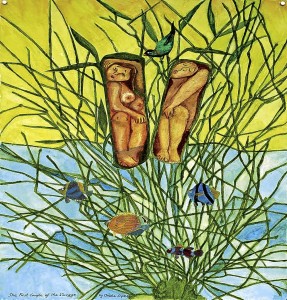
Two superior beings lived in space, but they did not know of each other’s existence. Then it occurred to them simultaneously that they must create matter on which they could stand, walk and plant.
And so Manama, the good being, made an earthworld using the cuttings of his fingernails. Since he was squeaky clean, he produced an antiseptic world of rocks and stones. The Bad God, Ogassi, on the other hand, created his world out of the cuttings of his dirty toenails. He produced a wet world of dirt and soil. Each god also created water—Manama out of his perspiration, Ogassi out of his urine.
One day, the Good God perceived in the distance the handiwork of the Bad God. There were lush trees and plants growing in Ogassi’s world. For although Manama had tried so hard, only one tree grew in his dry and antiseptic kingdom. He could see, in the distance, birds and animals roaming as well in the Bad God’s world.
Manama ordered his servant, the susuwetan bird, to alight on Ogassi’s kingdom. When it returned, he scraped the rich, sticky soil from under the bird’s feet. This Manama enlarged until it could cover his entire world. Next, the bird was sent to peck on as many fruits in Ogassi’s world as it could. The susuwetan returned with its crop full of seeds. They soon became the vegetation in the Good God’s kingdom.
Groaning with fruit
One day, the bad deity, who had only one eye in the middle of his forehead, saw Manama’s world all green with plants groaning with fruit. “How have so many things grown out of what was nothing before?” Ogassi asked his followers, who all had one eye located on their foreheads like him. “Where else could he have stolen soil and seeds but from us!”
To revenge, the evil god created storms to crush the trees and plants in Manama’s kingdom. The devastation angered the Good God, who hurled thunderbolt after thunderbolt at Ogassi’s world until it was completely destroyed and dropped out of existence. But the Bad God and his followers were not destroyed, for like Manama, they, too, were immortal. They sought shelter in the forests, caves and mountains of the Good God’s kingdom.
To overcome so many of them, Manama created followers modeled after himself. Out of clay, he created a male and a female with two eyes, two hands and two feet. But while the Good God was searching for some ingredient to make them immortal, he left the figures untended on the riverbank. The evil god got some abaca fibers and mixed them with the black ones on the heads of the figures. This would make them age and have a limited life on Earth.
Manama continued to long for immortal companions. After thinking a long time, he instructed the susuwetan bird to peck on a big bamboo tree in his kingdom. The bamboo split open and out stepped the first immortal man and woman.
The pair from the bamboo was attracted to each other, but they did not know how to do the sex act. Lying on the grass, they would rub their bodies against each other and hug and nothing else. Once, when the male was lying on top of the female, the susuwetan bird tickled the male’s back and the pair learned how to procreate.
‘First father’
Their children became very numerous. The mortal children of the couple made of clay also multiplied. The different offspring intermarried and produced a sizable population. Villages were formed and there came a need for order. They revered Manama and called him their “first father.” The first child of the immortal couple of the bamboo, as expected, became Manama’s chief assistant. The susuwetan bird became the official messenger. And the world got on.
Nota Bene: This beautiful creation story has often bothered me. Dr. Arsenio Manuel, who accessed it from the Manuvu of Mt. Apo in Davao, was a good friend. We often had lunch together. He always referred to the “two superior beings” as “the Good God and the Bad God.”
I wondered why it was Manama who was “good” when (1) he stole soil from the other’s creation, and when Ogassi got mad, sent storms to the Good God’s kingdom, and (2) Manama sent “thunderbolt after thunderbolt until the world of the Bad God dropped out of existence.” Which, if you take it in the context of modern history, will raise the moral question, is might right? It reminds one of America’s A-Bomb, which laid Hiroshima to waste and ended World War II.
“The Good God and the Bad God” has become part of a book of myths and folktales called “A Treasury of Stories,” published by Anvil. For better readability, the stories researched by Dr. Manuel were rewritten by me and this story’s title gleaned from our oral lunch talks. Since the book may now be used by young students, I should have made clear (as Dr. Manuel would have if he were alive) that they come from a different cultural milieu.
There was no organized system of laws yet then; in the north, headhunting was the way to settle disputes. In the south, it also was “an eye for an eye”—but not two eyes. You could exact one life from another tribe in exchange for one taken from yours, but you don’t finish off the whole tribe. That system of justice among non-Christian minorities prevailed for a long, long time. But no longer today.
(Santa’s coming. Be good.)